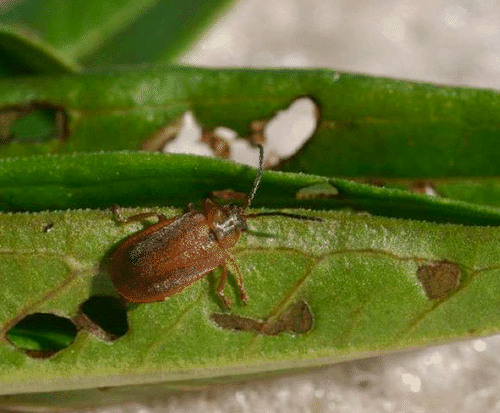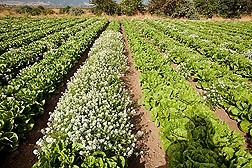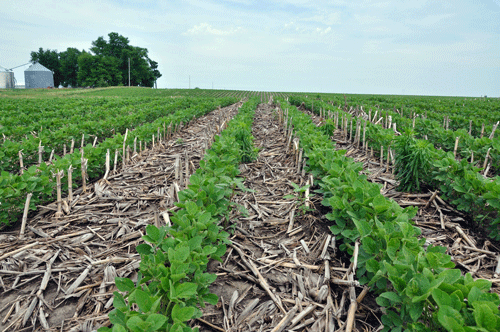7.3: Sustainable Agriculture
- Page ID
- 11774
\( \newcommand{\vecs}[1]{\overset { \scriptstyle \rightharpoonup} {\mathbf{#1}} } \)
\( \newcommand{\vecd}[1]{\overset{-\!-\!\rightharpoonup}{\vphantom{a}\smash {#1}}} \)
\( \newcommand{\dsum}{\displaystyle\sum\limits} \)
\( \newcommand{\dint}{\displaystyle\int\limits} \)
\( \newcommand{\dlim}{\displaystyle\lim\limits} \)
\( \newcommand{\id}{\mathrm{id}}\) \( \newcommand{\Span}{\mathrm{span}}\)
( \newcommand{\kernel}{\mathrm{null}\,}\) \( \newcommand{\range}{\mathrm{range}\,}\)
\( \newcommand{\RealPart}{\mathrm{Re}}\) \( \newcommand{\ImaginaryPart}{\mathrm{Im}}\)
\( \newcommand{\Argument}{\mathrm{Arg}}\) \( \newcommand{\norm}[1]{\| #1 \|}\)
\( \newcommand{\inner}[2]{\langle #1, #2 \rangle}\)
\( \newcommand{\Span}{\mathrm{span}}\)
\( \newcommand{\id}{\mathrm{id}}\)
\( \newcommand{\Span}{\mathrm{span}}\)
\( \newcommand{\kernel}{\mathrm{null}\,}\)
\( \newcommand{\range}{\mathrm{range}\,}\)
\( \newcommand{\RealPart}{\mathrm{Re}}\)
\( \newcommand{\ImaginaryPart}{\mathrm{Im}}\)
\( \newcommand{\Argument}{\mathrm{Arg}}\)
\( \newcommand{\norm}[1]{\| #1 \|}\)
\( \newcommand{\inner}[2]{\langle #1, #2 \rangle}\)
\( \newcommand{\Span}{\mathrm{span}}\) \( \newcommand{\AA}{\unicode[.8,0]{x212B}}\)
\( \newcommand{\vectorA}[1]{\vec{#1}} % arrow\)
\( \newcommand{\vectorAt}[1]{\vec{\text{#1}}} % arrow\)
\( \newcommand{\vectorB}[1]{\overset { \scriptstyle \rightharpoonup} {\mathbf{#1}} } \)
\( \newcommand{\vectorC}[1]{\textbf{#1}} \)
\( \newcommand{\vectorD}[1]{\overrightarrow{#1}} \)
\( \newcommand{\vectorDt}[1]{\overrightarrow{\text{#1}}} \)
\( \newcommand{\vectE}[1]{\overset{-\!-\!\rightharpoonup}{\vphantom{a}\smash{\mathbf {#1}}}} \)
\( \newcommand{\vecs}[1]{\overset { \scriptstyle \rightharpoonup} {\mathbf{#1}} } \)
\( \newcommand{\vecd}[1]{\overset{-\!-\!\rightharpoonup}{\vphantom{a}\smash {#1}}} \)
\(\newcommand{\avec}{\mathbf a}\) \(\newcommand{\bvec}{\mathbf b}\) \(\newcommand{\cvec}{\mathbf c}\) \(\newcommand{\dvec}{\mathbf d}\) \(\newcommand{\dtil}{\widetilde{\mathbf d}}\) \(\newcommand{\evec}{\mathbf e}\) \(\newcommand{\fvec}{\mathbf f}\) \(\newcommand{\nvec}{\mathbf n}\) \(\newcommand{\pvec}{\mathbf p}\) \(\newcommand{\qvec}{\mathbf q}\) \(\newcommand{\svec}{\mathbf s}\) \(\newcommand{\tvec}{\mathbf t}\) \(\newcommand{\uvec}{\mathbf u}\) \(\newcommand{\vvec}{\mathbf v}\) \(\newcommand{\wvec}{\mathbf w}\) \(\newcommand{\xvec}{\mathbf x}\) \(\newcommand{\yvec}{\mathbf y}\) \(\newcommand{\zvec}{\mathbf z}\) \(\newcommand{\rvec}{\mathbf r}\) \(\newcommand{\mvec}{\mathbf m}\) \(\newcommand{\zerovec}{\mathbf 0}\) \(\newcommand{\onevec}{\mathbf 1}\) \(\newcommand{\real}{\mathbb R}\) \(\newcommand{\twovec}[2]{\left[\begin{array}{r}#1 \\ #2 \end{array}\right]}\) \(\newcommand{\ctwovec}[2]{\left[\begin{array}{c}#1 \\ #2 \end{array}\right]}\) \(\newcommand{\threevec}[3]{\left[\begin{array}{r}#1 \\ #2 \\ #3 \end{array}\right]}\) \(\newcommand{\cthreevec}[3]{\left[\begin{array}{c}#1 \\ #2 \\ #3 \end{array}\right]}\) \(\newcommand{\fourvec}[4]{\left[\begin{array}{r}#1 \\ #2 \\ #3 \\ #4 \end{array}\right]}\) \(\newcommand{\cfourvec}[4]{\left[\begin{array}{c}#1 \\ #2 \\ #3 \\ #4 \end{array}\right]}\) \(\newcommand{\fivevec}[5]{\left[\begin{array}{r}#1 \\ #2 \\ #3 \\ #4 \\ #5 \\ \end{array}\right]}\) \(\newcommand{\cfivevec}[5]{\left[\begin{array}{c}#1 \\ #2 \\ #3 \\ #4 \\ #5 \\ \end{array}\right]}\) \(\newcommand{\mattwo}[4]{\left[\begin{array}{rr}#1 \amp #2 \\ #3 \amp #4 \\ \end{array}\right]}\) \(\newcommand{\laspan}[1]{\text{Span}\{#1\}}\) \(\newcommand{\bcal}{\cal B}\) \(\newcommand{\ccal}{\cal C}\) \(\newcommand{\scal}{\cal S}\) \(\newcommand{\wcal}{\cal W}\) \(\newcommand{\ecal}{\cal E}\) \(\newcommand{\coords}[2]{\left\{#1\right\}_{#2}}\) \(\newcommand{\gray}[1]{\color{gray}{#1}}\) \(\newcommand{\lgray}[1]{\color{lightgray}{#1}}\) \(\newcommand{\rank}{\operatorname{rank}}\) \(\newcommand{\row}{\text{Row}}\) \(\newcommand{\col}{\text{Col}}\) \(\renewcommand{\row}{\text{Row}}\) \(\newcommand{\nul}{\text{Nul}}\) \(\newcommand{\var}{\text{Var}}\) \(\newcommand{\corr}{\text{corr}}\) \(\newcommand{\len}[1]{\left|#1\right|}\) \(\newcommand{\bbar}{\overline{\bvec}}\) \(\newcommand{\bhat}{\widehat{\bvec}}\) \(\newcommand{\bperp}{\bvec^\perp}\) \(\newcommand{\xhat}{\widehat{\xvec}}\) \(\newcommand{\vhat}{\widehat{\vvec}}\) \(\newcommand{\uhat}{\widehat{\uvec}}\) \(\newcommand{\what}{\widehat{\wvec}}\) \(\newcommand{\Sighat}{\widehat{\Sigma}}\) \(\newcommand{\lt}{<}\) \(\newcommand{\gt}{>}\) \(\newcommand{\amp}{&}\) \(\definecolor{fillinmathshade}{gray}{0.9}\)Some terms defy definition. "Sustainable agriculture" has become one of them. In such a quickly changing world, can anything be sustainable? What do we want to sustain? How can we implement such a nebulous goal? Is it too late? With the contradictions and questions have come a hard look at our present food production system and thoughtful evaluations of its future. If nothing else, the term "sustainable agriculture" has provided "talking points," a sense of direction, and an urgency, that has sparked much excitement and innovative thinking in the agricultural world.
"Sustainable agriculture" was addressed by Congress in the 1990 "Farm Bill". Under that law, "the term sustainable agriculture means an integrated system of plant and animal production practices having a site-specific application that will, over the long term:
- satisfy human food and fiber needs;
- enhance environmental quality and the natural resource base upon which the agricultural economy depends;
- make the most efficient use of nonrenewable resources and on-farm resources and integrate, where appropriate, natural biological cycles and controls;
- sustain the economic viability of farm operations; and
- enhance the quality of life for farmers and society as a whole."
Organic Farming is Good for Farmers, Consumers and the Environment
Organic agriculture is an ecological production management system that promotes and enhances biodiversity, biological cycles and soil biological activity. It is based on minimal use of off-farm inputs and on management practices that restore, maintain and enhance ecological harmony (NAL, 2015). Organic food is produced by farmers who emphasize the use of renewable resources and the conservation of soil and water to enhance environmental quality for future generations. Organic meat, poultry, eggs, and dairy products come from animals that are given no antibiotics or growth hormones. Organic food is produced without using most conventional pesticides; fertilizers made with synthetic ingredients or sewage sludge; bioengineering; or ionizing radiation (NAL, 2015).
Organic production, with the corresponding practices to maintain soil fertility and soil health is therefore a more benign alternative to conventional, high-value horticulture. The organic food movement has been endorsed by FAO, which maintains in a report (FAO 2007) that organic farming fights hunger, tackles climate change, and is good for farmers, consumers, and the environment. The strongest benefits of organic agriculture are its use of resources that are independent of fossil fuels, are locally available, incur minimal agroecological stresses, and are cost effective (FAO 2007). Some have argued that women farmers, who already rely on few external inputs, may be well positioned to become organic producers and benefit from the rising interest in organic produce.
IPM is a Combination of Common-Sense Practices
Integrated Pest Management (IPM) refers to a mix of farmer-driven, ecologically based pest control practices that seeks to reduce reliance on synthetic chemical pesticides. It involves (a) managing pests (keeping them below economically damaging levels) rather than seeking to eradicate them; (b) relying, to the extent possible, on non-chemical measures to keep pest populations low; and (c) selecting and applying pesticides, when they have to be used, in a way that minimizes adverse effects on beneficial organisms, humans, and the environment. It is commonly understood that applying an IPM approach does not necessarily mean eliminating pesticide use, although this is often the case because pesticides are often over-used for a variety of reasons (Figure below).
There are also cases where an increase in pesticide use could be justified, however pesticides should only be used when it is economically justified to do so. The IPM approach regards pesticides as mainly short-term corrective measures when more ecologically based control measures are not working adequately (sometimes referred to as using pesticides as the “last resort”). In those cases when pesticides are used, they should be selected and applied in such a manner as to minimize the amount of disruption that they cause to the agro-ecological system (i.e., to the extent possible, use products that are non-persistent, with very selective action and apply them in the most targeted possible way).
Origin of Integrated Pest Management
The scientific basis of “Integrated Pest Control” evolved over a period of about 10 years, mainly among researchers at the University of California. The concept was explicitly defined in 1965 at a symposium sponsored by the Food and Agriculture Organization (FAO), of the United Nations, held in Rome, Italy (FAO 1966b). The concept of “Integrated Control,” originally limited to the combination of chemical and biological control methods (Michelbacher & Bacon 1952), was greatly expanded in that symposium to become synonymous with what we now consider IPM. Concurrently, however, the concept of “Pest Management” that had been proposed by Australian ecologists in 1961 (Geyer & Clark 1961), started receiving greater recognition. Publication of Geyer’s Annual Review of Entomology article in 1966 (Geyer 1966), a report by the US National Academy of Sciences (NAS 1969), and the proceedings of a conference held in North Carolina, which included participation by the original proponents of pest management from Australia (Rabb and Guthrie 1970), provided the impetus for that recognition. The convergence of the concepts of integrated control and pest management, and the ultimate synthesis into integrated pest management, opened a new era in the protection of agricultural crops, domestic animals, stored products, public health, and the structure of human dwellings against the attack of arthropod pests, plant and animal diseases, and weeds. A more detailed account of the historical development of IPM is found in Kogan (1998).
Biological Control
Biological control (biocontrol) is the use of one biological species to reduce populations of a different species (EPA, 1998). There has been a substantial increase in commercialization of biocontrol products, such as beneficial insects, cultivated predators and natural or non-toxic pest control products. Biocontrol is being mainstreamed to major agricultural commodities, such as cotton, corn and most commonly vegetable crops. Biocontrol is also slowly emerging in vector control in public health and in areas that for a long time mainly focused on chemical vector control in mosquito/malaria—and black fly/onchocerciasis—control programs. Successful and commercialized examples of biocontrol include ladybugs to depress aphid populations, parasitic wasps to reduce moth populations, use of the bacterium Bacillus thuringenensis to kill mosquito and moth larvae, and introduction of fungi, such as Trichoderma, to suppress fungal-caused plant diseases, leaf beetle (Galerucella calmariensis) to suppress Purple loosestrife, a noxious weed (Figure below).

Figure \(\PageIndex{1}\): Young larvae feed in and on the developing buds, often destroying them, which may stunt plants and delay or prevent flowering. Adults and older larvae feed on leaves and cause severe defoliation.
In all of these cases, the idea is not to completely destroy the pathogen or pest, but rather to reduce the damage below economically significant values.
Intercropping Promotes Plant Interactions
Intercropping means growing two or more crops in close proximity to each other during part or all of their life cycles) to promote interactions that improve soil and water quality via increased biodiversity and contribute to pest management. Incorporating intercropping principles into an agricultural operation increases diversity and interaction between plants, arthropods, mammals, birds and microorganisms resulting in a more stable crop-ecosystem and a more efficient use of space, water, sunlight and nutrients (Figure below).

Figure \(\PageIndex{2}\): Intercropping alyssum with organic romaine lettuce for aphid control
Furthermore, soil health is benefited by increasing ground coverage with living vegetation, which reduces erosion, and by increasing the quantity and diversity of root exudates, which enhance soil fauna. This collaborative type of crop management mimics nature and is subject to fewer pest outbreaks, improved nutrient cycling and crop nutrient uptake, and increased water infiltration and moisture retention. Soil quality, water quality and wildlife habitat all benefit
Conservation Farming Practices Reduce Unnecessary Input Use
In modern agricultural practices, heavy machinery is used to prepare the seedbed, for planting, to control weeds, and to harvest the crop. The use of heavy equipment has many advantages in saving time and labor, but can cause compaction of soil and disruption of the natural soil biota. Much compaction is reversible and some is unavoidable with modern practices; however, serious compaction issues can occur with excessive passage of equipment during times when the soil has a high water content. The problem with soil compaction is that increased soil density limits root penetration depth and may inhibit proper plant growth.
Alternative practices generally encourage minimal tillage or no tillage methods. With proper planning, this can simultaneously limit compaction, protect soil biota, reduce costs (if performed correctly), promote water infiltration, and help to prevent topsoil erosion (Figure below).

Figure \(\PageIndex{3}\): Farmers should consider no-till farming as the most important tool to prevent loss of soil moisture.
Tillage of fields does help to break up clods that were previously compacted, so best practices may vary at sites with different soil textures and composition. Another aspect of soil tillage is that it may lead to more rapid decomposition of organic matter due to greater soil aeration. Over large areas of farmland, this has the unintended consequence of releasing more carbon and nitrous oxides (greenhouse gases) into the atmosphere, thereby contributing to global warming effects. In no-till farming, carbon can actually become sequestered into the soil.
Thus, no-till farming may be advantageous to sustainability issues on the local scale and the global scale. No-till systems of conservation farming have proved a major success in Latin America and are being used in South Asia and Africa.
Crop Rotation
Crop rotations are planned sequences of crops over time on the same field. Rotating crops provides productivity benefits by improving soil nutrient levels and breaking crop pest cycles. Farmers may also choose to rotate crops in order to reduce their production risk through diversification or to manage scarce resources, such as labor, during planting and harvesting timing. This strategy reduces the pesticide costs by naturally breaking the cycle of weeds, insects and diseases. Also, grass and legumes in a rotation protect water quality by preventing excess nutrients or chemicals from entering water supplies.

